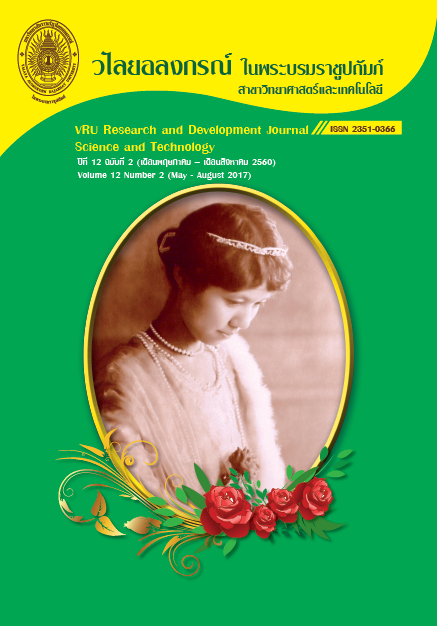การประยุกต์ใช้น้ำมันรำข้าวและสารสกัดจากรำข้าวหอมมะลิแดงในเครื่องสำอางสำหรับผิว
Main Article Content
Abstract
การศึกษาปริมาณแกมมาออริซานอลและวิตามินอีจากน้ำมันรำข้าวหอมมะลิแดง พบว่าน้ำมันรำข้าวหอมมะลิแดง 1 กรัม มีปริมาณแกมมาออริซานอล 14.06 มิลลิกรัม และปริมาณวิตามินอี 49.47 มิลลิกรัม วิเคราะห์ฤทธิ์ต้านอนุมูลอิสระด้วยวิธี DPPH และปริมาณสารฟีนอลิกทั้งหมดด้วยวิธี Folin-Ciocalteu reagent ของสารสกัดกากรำข้าวหอมมะลิแดง พบว่ามีค่าความเข้มข้นในการยับยั้งอนุมูลอิสระที่ร้อยละ 50 (IC50) เท่ากับ 0.437 ไมโครกรัม/มิลลิลิตร และปริมาณสารฟีนอลิกทั้งหมดคือ 150.82 มิลลิกรัมสมมูลของกรดแกลลิกต่อกรัมของสารสกัด ประยุกต์ใช้น้ำมันรำข้าวและสารสกัดกากรำข้าวหอมมะลิแดงในเครื่องสำอาง 3 ผลิตภัณฑ์คือ ครีมสำหรับผิวธรรมดา ครีมสำหรับผิวแห้ง และครีมสำหรับผิวมัน ครีมทั้ง 3 ผลิตภัณฑ์ผ่านการทดสอบความคงสภาพทางกายภาพ เคมี จุลชีววิทยาและความพึงพอใจของผู้บริโภค จากการศึกษานี้แสดงให้เห็นว่าน้ำมันรำข้าวและสารสกัดกากรำข้าวหอมมะลิแดงมีศักยภาพในการนำมาใช้ในเครื่องสำอางได้
Study on g-oryzanol and vitamin E of red jasmine rice bran oil (RBO), was found that 1 gram of RBO contained g-oryzanol 14.06 mg and vitamin E 49.47 mg. Analysis of antioxidant activity by DPPH method and total phenolic content by Folin-Ciocalteu reagent of defatted red jasmine rice bran extract (DRBE), the DRBE was showed the concentration of free radical inhibitor at 50% (IC50) as 0.437 mg/ml and total phenolic content as 150.82 mg GAE/g of extract. Apply RBO and DRBE in three cosmetics as normal skin cream, dry skin cream and oily skin cream. All three creams have been testes for physical, chemical and microbiological stability included consumer satisfaction. This study shows that RBO and DRBE have the potential to use in cosmetics.
Downloads
Article Details
Copyright Notice
The copyright of research articles published in the VRU Research and Development Journal Science and Technology Journal belongs to the Research and Development Institute, Valaya Alongkorn Rajabhat University under the Royal Patronage. Reproduction of the content, in whole or in part, is prohibited without prior written permission from the university.
Responsibility
The content published in the VRU Research and Development Journal Science and Technology Journal is the sole responsibility of the author(s). The journal does not assume responsibility for errors arising from the printing process.
References
พิมพร ลีลาพรพิสิฐ. 2540. อิมัลชันทางเครื่องสำอาง. กรุงเทพมหานคร: สำนักพิมพ์ โอ.เอส.พริ้นติ้ง เฮ้าส์.
ลือชัย บุตคุป. (2012). สารประกอบฟีนอลิกและฤทธิ์ทางชีวภาพ. Journal of Science and Technology MSU. 31(4): 444-456.
ศิริวรรณ สุทธจิตต์. (2550). คู่มือสุขภาพเกี่ยวกับวิตามิน. พิมพ์ครั้งที่ 1. กรุงเทพมหานคร. สำนักพิมพ์The Knowledge Center.
ไสว พงษ์เก่า. 2534. พืชเศรษฐกิจเล่ม 2. ภาควิชาพืชไร่นาคณะเกษตร. กรุงเทพมหานคร: มหาวิทยาลัยเกษตรศาสตร์.
อรุณศรี ปรีเปรม, ผดุงขวัญ จิตโรภาส และบังอร ศรีพานิชกุลชัย. (2549). รำข้าวที่มีคุณภาพ คุณค่าต่อสุขภาพ. ศูนย์วิจัยและพัฒนาผลิตภัณฑ์จากสมุนไพร คณะเภสัชศาสตร์ มหาวิทยาลัยขอนแก่น. วารสารศูนย์วิชาการ. ปีที่ 2 ฉบับที่ 2.
American Society for Testing Materials. 1991. Standard test method for preservatives in water-containing cosmetics, E 640-78. Annual Book of ASTM Standards, Philadelphia, PA.
Bucci, R., Magri, A. D., Magri, A. L., and Marini, F. (2003) Comparison of three spectrophotometric methods for the determination of gamma-oryzanol in rice bran oil. Analytical Bioanalytical Chemistry, 375(8): 1254-1259.
Detmer, A., C. JØrgensen, and D. Nylén. 2010. A guidance document on microbiological control of cosmetic products. Danish Ministry of the Environment. 43 p.
Ghasemzadeh, A., Jaafar, H.Z.E., Juraimi, A.S. and Tayebi-Meigooni, A. (2015). Comparative evaluation of different extraction techniques and solvent for the assay of phytochemicals and antioxidant activity of Hashemi rice bran. Molecules, 20: 10822-10838.
Goufo, P. and Trindade, H. (2014) Rice antioxidants: phenolic acids, flavonoids, anthocyanins, tocopherols, tocotrienils, -oryzanol, and phytic acid. Food Science & Nutrition. 2(2): 75-104.
Kaushik, P., Goyal, P., Chauhanm A. and Chauhan, G. (2008). In vitro evaluation of antibacterial potential of dry fruit extracts of Elettaria cardamomum Maton (Chhoti Elaichi). Iranian Journal of Pharmaceutical Research. 9(3); 287-292.
Pate, M. and Naik, S.N. (2004). Gamma-oryzanol from rice bran oil-A review. Journal of Scientific & Industrial Research. 63: 569-578.
Manosroi, A., Chutiprapat, R., Abe, M., Manosroi, W. and Manosroi, J. (2012). Anti-aging efficacy of topical formulations containing niosomes entrapped with rice bran bioactive compounds. Pharmaceutical Biology; 50(2):208-224.
Vorarat, S., Managit, C., Iamthanakul, L., Soparat, W. and Kamkaen, N. (2010). Examination of antioxidant activity and development of rice bran oil and gamma-oryzanol microemulsion. Journal of Health Research, 24(2): 67-72.
Sakunpak, A., Suksaeree, J., Monton, C., Pathompak, P. and Kraisintu, K. (2014). Quantitative analysis of -oryzanol content in cold press rice bran oil by TLC-image analysis method. Asian Pacific Journal of Tropical Biomedicine, 4(2): 119-123.
Suher, WN. And Husni, DN. 2017. Effect of cream base types on the antioxidant activity of the cream preparation of red rice bran extract. Research Journal of Phermaceutical, Biological and Chemical Sciences; 8(15): 255-262.
Tsai, T.H., Tsai, P.J. and Ho, S.C. (2005). Antioxidant and anti-inflammatory activity of several commonly species. Journal of Food Science. 70(1); 93-97.


